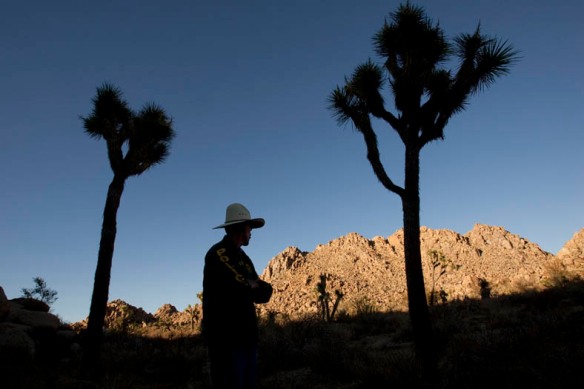
Undercover special agent Todd Swain is charged with protecting cultural artifacts in National Parks like Joshua Tree.
Making our way down a rutted trail after a long drive along a dusty fire road, the two men, one a undercover federal agent and the other a middle aged archaeologist for the Bureau of Land Management, led me to a site that left me in awe. On both sides of me were twenty foot walls of dark rock with ancient petroglyphs nearly everywhere the eye could see. Trying to decipher the meaning of the rock art is a lesson in individual interpretation I was told, but nonetheless I was shown many different drawings that depicted primitive man, animals (believed to be snakes, bighorn sheep) and markings that are believed to record time. It was fascinating.

Rock art near the Ord and Rodman mountains is often damaged and removed illegally and sold on the internet or to dealers.
Until you saw the large chunks of rock that were removed to reveal the much lighter color underneath. Further inspection showed where large chisels were placed and the slabs containing rock art were removed. The assumption, based on the expertise of Todd Swain, the undercover agent for the National Park Service and considered one of a few experts in cultural artifact theft, is that looters removed the art and either sold it on the internet or to antiquity dealers. As the Los Angeles Times noted in today’s front page story, and Preservation magazine detailed in their January/February cover story for which I was shooting, looting of Native American artifacts is particularly common in the Southwest. In Utah, several people involved in a case of dealing with allegedly looted artifacts have committed suicide.
From Joshua Tree National Park to near Barstow, CA and places far between, looters are illegally removing cultural artifacts for their own pleasure and financial gain. While we roamed the expansive terrain of Joshua Tree near dusk, the golden hour light casting a warm glow on the rock formations, it was explained how difficult it is to stop the illicit activity. With millions of acres containing artifacts and few NPS agents, the chance of catching someone in the act of looting is rare, Swain admits. But the evidence of looting is abundant. Large, partially filled holes dot the landscape where “twiggers”, a term referring to tweekers (meth addicts) who are diggers, have excavated an area in an effort to recover pottery shards, arrowheads, tools and other artifacts. Broken pieces of wood that likely made sifters lay nearby. Once the artifacts are taken, prosecution is admittedly difficult. So Swain works undercover posing as a buyer in hopes of gaining the trust of sellers who might admit the items were looted. Without the admission, it’s nearly impossible to prove the items were stolen.
So the next time I’m wandering through a quaint Southwest art store in towns from Palm Desert to Tucson, I’ll give some thought to purchasing anything that could have been removed from a ancient Native American colony. And I certainly won’t ever consider purchasing rock art that comes on a broken piece of slab.


